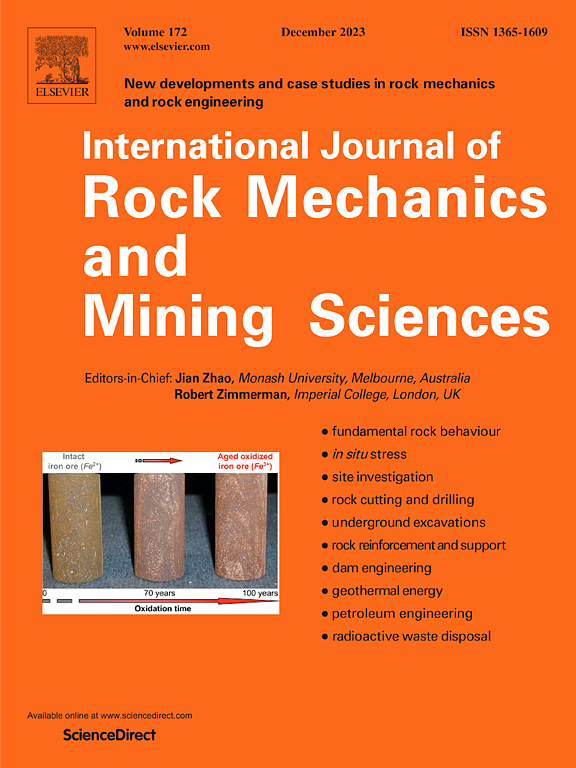Optical quantification and characterization of 3D stress fields and plastic zones around arch tunnel models using stress freezing and 3D printing techniques
IF 7
1区 工程技术
Q1 ENGINEERING, GEOLOGICAL
International Journal of Rock Mechanics and Mining Sciences
Pub Date : 2025-03-12
DOI:10.1016/j.ijrmms.2025.106088
引用次数: 0
Abstract
Accurate characterization and quantification of the three-dimensional (3D) stress field and plastic zones around tunnels are vital for predicting potential rock bursts and spalling disasters and providing a quantitative basis for rational support design. However, the 3D stress field and plastic deformations around tunnels cannot be easily quantified experimentally because of the limitations of conventional experimental techniques. In this study, a novel experimental method combining photoelastic stress-freezing, phase shifting, and phase unwrapping techniques was proposed to quantitatively characterize the principal stress difference and shear stress around an arch tunnel model fabricated using 3D printing. The plastic deformation zones and elastoplastic boundaries around the tunnel were quantitatively defined using the Tresca yield criterion and stress-optic law. The experimental results obtained by the proposed method were compared with the simulation results of the 3D stress and plastic deformations around the tunnel. The results indicated that the areas with high stresses were primarily located at the corners, sidewalls, and shoulders of the arch tunnel. The sidewalls are stress disturbance zones, whereas the top and bottom are rapidly changing stress zones, indicating that disasters are prone to occur in these areas. Plastic zones were formed primarily at the sidewalls, corners, and shoulders of the tunnel, and the entire morphology exhibited a butterfly shape. The proposed method demonstrates good potential for validating numerical solutions. This study contributes to the understanding of the failure mechanisms of underground tunnels and enhances the prediction and prevention of tunnel disasters.
利用应力冻结和3D打印技术对拱形隧道模型的三维应力场和塑性区进行光学量化和表征
准确表征和量化隧道周边三维应力场和塑性区,对于预测潜在的地压和崩落灾害,为合理的支护设计提供定量依据至关重要。然而,由于传统实验技术的限制,隧道周围的三维应力场和塑性变形不容易在实验中量化。本研究提出了一种结合光弹性应力冻结、相移和相解包裹技术的实验方法,用于定量表征3D打印的拱形隧道模型周围的主应力差和剪应力。利用Tresca屈服准则和应力-光学定律定量确定了隧道周围的塑性变形区和弹塑性边界。将该方法得到的试验结果与隧道周围三维应力和塑性变形的模拟结果进行了比较。结果表明:拱型隧道的高应力区域主要分布在拱型隧道的弯角、侧壁和拱肩。侧壁是应力扰动区,顶部和底部是快速变化的应力区,表明这些区域容易发生灾害。塑性区主要在隧道的侧壁、角落和肩部形成,整个形态呈蝴蝶状。该方法对数值解的验证具有良好的潜力。该研究有助于认识地下隧道的破坏机理,提高隧道灾害的预测和预防水平。
本文章由计算机程序翻译,如有差异,请以英文原文为准。
求助全文
约1分钟内获得全文
求助全文
来源期刊
CiteScore
14.00
自引率
5.60%
发文量
196
审稿时长
18 weeks
期刊介绍:
The International Journal of Rock Mechanics and Mining Sciences focuses on original research, new developments, site measurements, and case studies within the fields of rock mechanics and rock engineering. Serving as an international platform, it showcases high-quality papers addressing rock mechanics and the application of its principles and techniques in mining and civil engineering projects situated on or within rock masses. These projects encompass a wide range, including slopes, open-pit mines, quarries, shafts, tunnels, caverns, underground mines, metro systems, dams, hydro-electric stations, geothermal energy, petroleum engineering, and radioactive waste disposal. The journal welcomes submissions on various topics, with particular interest in theoretical advancements, analytical and numerical methods, rock testing, site investigation, and case studies.

 求助内容:
求助内容: 应助结果提醒方式:
应助结果提醒方式:


